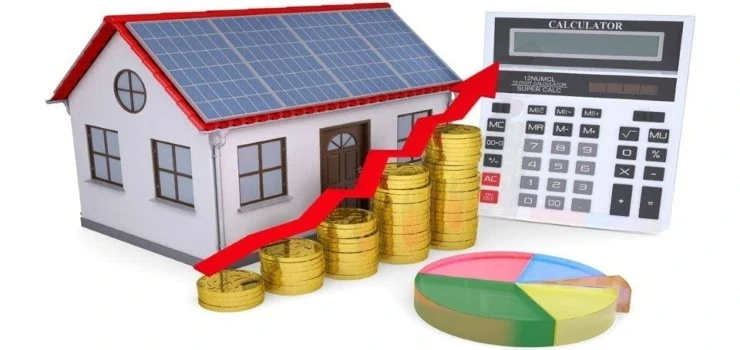
The cost of going solar can be intimidating, requiring a significant initial investment to get a system up and running.
However, the prospect of lowered monthly energy bills and increased home value promises to offset the costs in due time. Most solar buyers are enticed to get a system on the idea that it will “pay for itself.”
The question for prospective buyers becomes “how long will it take for my solar system to pay for itself?” In other words, at what point will the total amount of money saved equal the total amount that was invested in going solar?
The average solar system pays for itself in around eight years. With an expected lifespan of 25 years or more, you can expect your system to pay for itself and then some over time (all while increasing the value of your home and lowering your carbon footprint).
To get the exact answer to that question you need to calculate the total system cost, deduct the incentives/rebates available to you, and then estimate the expected amount of energy the system will produce.
SYSTEM COST
The average 6KW system in California costs around $16,140. This can be higher or lower depending on:
SIZE – More solar panels = more money. However, more solar panels = more energy production. A bigger system might cost more initially but save you exponentially more in the long run.
PANELS – Not all panels are created equal. Better manufacturers produce panels that are less likely to break and retain higher solar production over time.
INSTALLATION – System costs can increase or decrease depending on the complexity of the installation. If the roof isn’t ideal for an installation, you might need roofing work (which adds to the overall cost). Not every solar contractor charges the same rates either – companies with better reputations sometimes charge more since their quality of work is proven and they typically complete installations quicker. Lastly, there are some minor costs for permits and a fee for interconnection to the grid.
INCENTIVES & REBATES
There are plenty of ways to save big going solar thanks to generous incentives and rebates such as:
Federal Solar Tax Credit (ITC) – You can get a 26% Federal Tax Credit on home solar systems that are installed before the end of 2022.
Self-Generation Incentive Program (SGIP) – You can get a rebate for buying and installing a solar battery with your rooftop system (this varies by utility and battery storage capacity).
Solar Energy System Property Tax Exclusion – You can get a property tax exclusion on the added home value from getting a rooftop solar system.
Single-Family Affordable Solar Housing (SASH) – You can get cash incentives for every kilowatt (KW) of solar power installed if you are an eligible low-income homeowner that gets electricity from PG&E, SCE, or SDG&E.
ENERGY PRODUCTION
The goal with a solar energy system is to generate enough energy to offset most energy costs you regularly incur.
Solar contractors will use historical system data to calculate your average energy consumption. They will then determine what size system would be required to generate enough energy for the system to be financially viable.
In other words, you will need to get a system that generates enough energy relative to how much your household consumes. If your home can’t support a system that generates significant energy or your household energy consumption is low, then going solar might not make the most financial sense.
OTHER FACTORS
Your total system cost is going to be affected by the following:
Solar Loans/Financing – If you are taking a loan to pay for the system you will need to calculate the interest and any other costs to get the “true system cost.”
Increasing Cost of Electricity – The cost of electricity over time tends to increase. Most utility companies will let you know about expected increases well in advance, but you can always look at past bills to roughly calculate what the average rate increase is over time.
THE FINAL CALCULATION
Now that you know the factors, you just need to get the initial data to make the final calculation on how fast your solar system will pay for itself. First, you want to calculate the true system cost as follows:
Total System Cost – The cost of your system including parts, labor, permits, and fees.
Incentives & Rebates – Deduct any tax credits/incentives/rebates from the total system cost.
Other Factors – If you are taking out a solar loan you need to calculate the total interest you expect to pay over the life of the loan; add this amount to the total system cost.
The final number you are left with is the true system cost. Now you just need to figure out how much you will save regularly on your energy bills:
Energy Production – The amount of energy the proposed system will generate (annually)
Energy Rate Increases – Determine what the gradual increase in cost of energy is to take that factor into account (relative to production)
The number you are left with is the annual amount you’ll save on electricity.
Take the true system cost and divide that by the annual savings and the number you’ll get will be roughly the number of years it will take for the system to pay for itself.
Most solar systems greatly increase home equity value immediately and over time, so there are untold financial benefits that can’t be easily calculated. You’ll also be reducing your carbon footprint, leading to a cleaner environment and a greener future for us all.
To get the most accurate assessment of how long it will take your solar energy system to pay for itself contact Sunline Energy today. We’re San Diego’s premier solar and roofing company – locally owned and operated with a 5-star overall rating on Yelp! We look forward to hearing from you so we can help you calculate how much going solar could save you well into the future.

